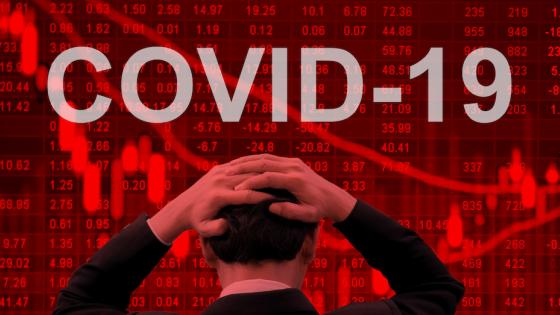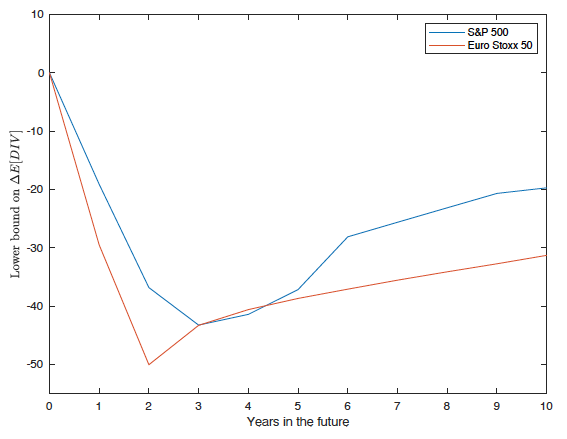The outbreak of coronavirus has caused a pandemic of respiratory disease (COVID-19) for which vaccines and targeted therapeutics for treatment are unavailable (Wang et al. 2020). The outbreak has caused major concerns about public health around the world. At the same time, there are growing concerns about the economic consequences as households are required to stay home to slow the spread of the virus. The impact that ’pausing’ the economy may have on supply chains, household demand, and the financial stability of the economy is largely unknown. As a result, policymakers, businesses, and market participants are trying to revise growth expectations in the short run and the long run.
As the current situation is unprecedented, and developing rapidly, models that use macroeconomic fundamentals may miss some of the key forces and may be too slow to update given the frequency with which macroeconomic data become available. It has long been recognised that asset prices may be particularly useful as they reflect investors’ expectations about future payoffs. A natural starting point may be equity markets, bond markets (Harvey 1989) and credit markets (Gilchrist and Zakrajsek 2012). Indeed, much of the media commentary has evolved around these markets. In particular, the movements in the stock market have received a lot of attention. In a new paper (Gormsen and Koijen 2020), we provide a perspective on how to interpret movements in the stock market and what it tells us about growth expectations by combining it with asset pricing data from other markets. Our work relates to Ramelli and Wagner (2020), who look at the cross-section of stock price reactions to COVID-19 events to understand the factors that impacted investors’ demand during the onset of the crisis.
Equity markets in the EU and US dropped by as much as 30%. This is an extraordinary amount. To interpret this decline, it is useful to recall that the value of the stock market is equal to the sum of the discounted value of all future dividends. For the stock market to decline by 30% only due to revised growth expectations, the shock to future dividends needs to be large and highly persistent. To see this, we can sum the dividend prices over the first ten years and find that this accounts for about 20% of the value of the stock market. This implies that if discount rates do not move and the economic impact on dividends lasts no more than ten years, a 30% decline in the stock market would mean that firms pay no dividends in the next ten years – seemingly a rather extreme scenario. However, this is typically not the right way to interpret movements in the stock market. The seminal works by Shiller (1981) and Campbell and Shiller (1988) show that most of the variation in the value of the stock market is due to changes in expected returns, not revisions in expected future growth rates.
This insight brings good and bad news. The good news is that investors’ expectations did not decline as dramatically as in the earlier calculation. The bad news, however, is that we learn little about growth expectations by taking cues from the stock market. Instead, we learn about investors’ changes in discount rates that may be driven by shifts in risk aversion, sentiment, or uncertainty about long-run growth. In our paper, we show that data from a related market, namely dividend futures, is useful to obtain estimates of growth expectations by maturity. Dividend futures are contracts that only pay the dividends of the aggregate stock market in a given year.1
By no arbitrage, if we sum all dividend strip prices, they add to the market. There are two important reasons that data on dividend strip prices are informative. First, van Binsbergen et al. (2013) show that prices of dividend strips are good forecasters of dividend growth, GDP growth, and consumption growth. Second, and particularly relevant during this period, dividend strips are differentiated by maturity, just like nominal and real bonds. We use this feature of the data to provide an estimate of expected growth over the next year and to obtain a lower bound on the term structure of growth expectations by maturity.
Figure 1 shows the dynamics of expected dividend and GDP growth expectations in the EU and in the US until 18 March. Growth expectations did not respond much to the Wuhan lockdown. Following the lockdown in Italy, growth expectations start to deteriorate. The travel restrictions on the visitors to the US from EU leads to a sharp deterioration of growth expectations and once again following the declaration of the national emergency and the subsequent actions by the Federal Reserve on 15 March. As of 18 March, dividend growth over the next year is down by 28% for the S&P 500 and 25% for the Euro Stoxx 50. The estimate of GDP growth over the next year is down by 2.6% in both the US and the EU.2 As a word of caution, we emphasise that these estimates are based on a forecasting model estimated using historical data. In turbulent and unprecedented times, there is a risk that the historical relation between growth and asset prices breaks down, meaning these estimates come with uncertainty.
Figure 1 Change in one-year growth expectations
We also derive a lower bound on expected dividend growth by horizon, which can be computed directly using observed prices. The lower bound is completely forward looking and requires neither a forecasting model nor historical data, which makes it useful in our setting, and only relies on the assumption that expected excess returns have increased. The lower bound is plotted in Figure 2. The figure has the lower bound on the change in expected dividends on the vertical axis and the horizon on the horizontal axis. As of 18 March, the lower bound is lowest on the two- to three-year horizon, where dividend growth have been revised down by as much as 43% in the US and 50% in the EU, compared to 15 January. There are signs of catch-up growth from year four to year ten as the bound is substantially higher on longer horizons. We study how the bound evolves over the outbreak in response to news and policy initiatives, which gives insights into how financial markets interpreted these events.
Figure 2 Lower bound on expected dividend growth
As of 18 March, the lower bound on dividend growth is as low as what we observed during November of the Global Crisis – at least on the short end. On the long end, the lower bound is still not as low as what we observed during the Global Crisis, potentially indicating that investors expect the current crisis to be shorter. As the crisis unfolds, we will update the estimates reported regularly online here.
References
Campbell, J Y and R J Shiller (1988), “The Dividend-Price Ratio and Expectations of Future Dividends and Discount Factors”, Review of Financial Studies 1(3): 195– 228.
Gilchrist, S and E Zakrajsek (2013), “Credit Spreads and Business Cycle Fluctuations”, American Economic Review 102(4): 1692–1720.
Gormsen, N J and R S J Koijen (2020), “Coronavirus: Impact on Stock Prices and Growth Expectations”, Working Paper, University of Chicago Booth School of Business.
Gormsen, N J (2020), “Time Variation of the Equity Term Structure”, Journal of Finance, forthcoming.
Harvey, C R (1989), “Forecasts of Economic Growth from the Bond and Stock Markets”, Financial Analysts Journal 45(5): 38–45.
Ramelli, S and A F Wagner (2020), “Feverish Stock Price Reactions to COVID-19”, Working Paper, University of Zurich.
Shiller, R J (1981), “Do Stock Prices Move Too Much to be Justified by Subsequent Changes in Dividends?”, American Economic Review 71(3): 421–436.
van Binsbergen, J H and R S J Koijen (2017), “The term structure of returns: Facts and theory”, Journal of Financial Economics 124(1): 1 – 21.
van Binsbergen, J, M Brandt and R Koijen (2012), “On the Timing and Pricing of Dividends”, American Economic Review 102(4): 1596–1618.
van Binsbergen, J, W Hueskes, R Koijen and E Vrugt (2013), “Equity yields”, Journal of Financial Economics 110(3): 503 – 519.
Wang, C, W Li, D Drabek, N M.A. Okba, R van Haperen, A D.M.E. Osterhaus, F J.M. van Kuppeveld, B L Haagmans, F Grosveld and B Bosch (2020), “A human monoclonal 1 antibody blocking SARS-CoV-2 infection”, bioRxiv.
Endnotes
1 See van Binsbergen et al. (2012), van Binsbergen et al. (2013), van Binsbergen and Koijen (2017), and Gormsen (2020) for earlier work on the properties of dividend futures.
2 The chief economist of Goldman Sachs, Jan Hatzius, revised his forecast for GDP growth in 2020 down to 0.4%, compared with a prior growth estimate of 1.2% on 15 March.





